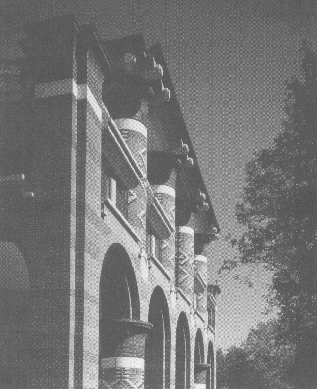
Spring/Summer 1999
Volume 6, Issue 2
Spring/Summer 1998
Volume
3, Issue 1
January 1995
Volume
2, Issue 4
October 1994
Volume
2, Issue 1
January 1994
 CRPC HEADQUARTERS MOVES INTO NEW HOME
CRPC HEADQUARTERS MOVES INTO NEW HOME
CRPC researchers and staff members and several of the computationally oriented departments at Rice University are moving into a new 112,000 square-foot, $16.5 million building this fall. Designed by renowned London architect John Outram, the building was dedicated in a ceremony on November 1 and named Duncan Hall in honor of former Rice Chairman of the Board and former U.S. Undersecretary of Defense and Secretary of Energy Charles Duncan and his wife Ann. It houses the Computer and Information Technology Institute, Computer Science Department, Computational and Applied Mathematics Department, CRPC, Statistics, and offices for the dean of engineering.
"Duncan Hall is designed to fulfill the university's interdisciplinary vision for computational engineering," says CRPC Director and Rice Noah Harding Professor Ken Kennedy. "The building allows for shared resources among departments as well as space for collaborations with visitors. This environment will facilitate the multidisciplinary work that has become the norm and not the exception in science and engineering today."
The three-story, five-wing building contains 240 offices for faculty, staff, and graduate students; three 45-seat classrooms; two 75-seat lecture halls; a 230-seat auditorium; six conference rooms; and more than a dozen laboratories equipped with computer workstations. The classrooms and conference rooms have audiovisual equipment for multimedia presentations and teleconferencing.
Duncan Hall's exterior features glazed brickwork, precast concrete columns, arched entryways, balconies, a large covered arcade, and a Spanish tile roof. Each wing is decorated with a distinctive brick pattern featuring glyphs drawn from different cultures to represent water, earth, air, and fire. The four classic elements are also represented throughout the interior of the building with the extensive use of color and design.
The openness of the interior environment is enhanced by a ceiling-high atrium with a brilliantly colored acoustic tile ceiling. Open stairways lead up to corridors and bridgeways that incorporate alcoves fitted with chairs and coffee tables to encourage visiting and communication. The offices are clustered around common meeting spaces, further encouraging teamwork and collaboration.
"We have worked very hard to create public spaces that will invite people to stop, linger, and talk to one another," says Keith Cooper, School of Engineering user liaison for Duncan Hall (see "Parallel Profile," page 7). "We also believe that the building's light, open environment will foster teamwork and productivity. More than three quarters of the offices have windows to the outdoors and most of the others have windows to inside spaces."
Table of Contents